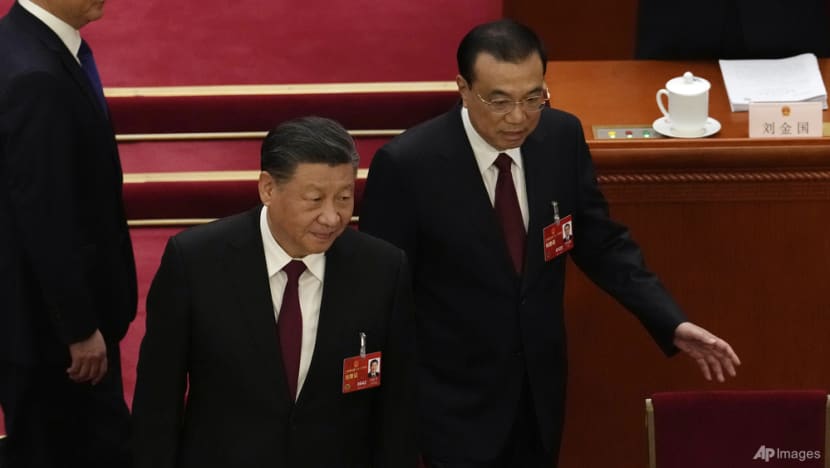Commentary: Slower growth rates simply the price China must pay for a maturing economy
Amid a major overhaul of its top economic team, China’s lowest GDP growth target in decades means meeting it becomes a reasonable endeavour, says Coface chief APAC economist Bernard Aw.

SINGAPORE: What is China counting on to reinvigorate the world’s second-largest economy? The 14th National People’s Congress (NPC), which started on Sunday (Mar 5), is being closely watched for details of its post-pandemic economic policy.
It has been more challenging than usual this year to understand the implications of its 2023 economic growth target, because of upcoming changes of unprecedented scale in economic leadership. Among those stepping down are Premier Li Keqiang, all four vice premiers including President Xi Jinping’s trusted economic tsar Liu He, and other key personnel like the finance minister and central bank governor.
At around 5 per cent, it is China’s lowest gross domestic product growth target in more than three decades, down even from the 5.5 per cent target in 2022 (which it did not meet).
SUBTLE CHANGES IN LI KEQIANG’S FINAL WORK REPORT
What does Li Keqiang’s final report on the work of the government - a key annual presentation that traditionally provides clues about economic tasks and policy for the year ahead - tell us?
For one, it was short on future plans - taking just six pages in the Chinese-language 32-page report - and long on the achievements in the past year. This is in contrast with previous years.
While it also reviewed work done over the past five years, given this marks the start of the government’s new five-year term, the section on upcoming priorities is still noticeably shorter than in the 2018 work report at the start of the previous term.
Noticeable too is the subtle change in language. Instead of setting out “tasks” or “requirements” as was done in previous years, the latest work report sets out “recommendations”.
This suggests that the report may not have a significant contribution from incoming premier Li Qiang’s team. More details on Li Qiang’s economic agenda could be unveiled in his press conference scheduled on the final day of the NPC on Mar 13.
But it will be a surprise if Li Qiang makes significant changes to the economic priorities set out in the work report. The recommendations do not seem to deviate from development priorities already communicated previously and widely.
In fact, the first five of eight key priorities highlighted in the report - such as expanding domestic demand, accelerating the modernisation of the industrial system and intensifying efforts to attract foreign investment - were mentioned in a recently published article by Xi Jinping, which was part of his speech at the annual Central Economic Work Committee meeting in December 2022.
At the NPC, Xi also reiterated the role of the private sector in improving innovation and productivity amid the push to become more self-reliant in tech. Notably, chip companies' representatives attended the parliamentary sessions for the first time.
Tech leaders who bore the brunt of regulatory tightening, like Tencent’s Pony Ma, were conspicuously absent. While platform Internet firms have been given some breathing room since, the regulatory environment is unlikely to return to the previous status quo.
A CONSERVATIVE GROWTH TARGET?
While this year’s GDP growth projection of 5 per cent seems conservative, it can be interpreted as a minimum target. More than half of China’s provincial-level regions expect their GDP growth rate to be 6 per cent or higher, with the weighted average of provincial GDP targets at 5.6 per cent.
The post-reopening recovery appeared well under way after some transitional pain from COVID-19 waves, with recent purchasing manager’s index (PMI) data indicating a strong pickup in economic activity.
The 2022 GDP growth of 3 per cent also provides a low comparison base, which should make meeting a 5 per cent growth rate a reasonable endeavour, setting up a positive start for the new economic leadership.
This is important to allay concerns over the lack of national-level policymaking experience of the incoming premier, unlike every other premier since 1988, which will go some distance to improve the confidence of markets and investors in the new leadership.
QUALITY GROWTH REQUIRES DEEPENING REFORMS
This gradual lowering of growth projections shows the emphasis that China is pushing for economic stability and quality development, rather than obsessing over growth. Slower growth rates are simply the price to be paid for a maturing economy, shifting towards a high-quality and sustainable development path.
What is more important is to continue deepening structural reforms and opening up the economy.
China faces structural economic and social ailments after 30 years of spectacular economic growth, averaging a GDP growth rate of 10 per cent per annum between 1978 and 2007. It is in a tough transition from an investment-led, labour-intensive economy to one driven by innovation and productivity, amid unfavourable demographic changes - a shrinking and ageing population and importantly, its workforce.
In recent years, China’s external environment also became more complex and challenging, marked by US-China strategic competition, and a reshuffling of the global supply chain, which contributed to the birth of the dual circulation growth strategy.
China paused reforms and launched stimulus in 2022 after the economy fell into a difficult situation in the middle of the year, compounded by Russia’s invasion of Ukraine and its zero-COVID policy. The bold reforms and regulatory tightening that had characterised 2021 were suspended, and Beijing brought back its old stimulus playbook - increasing infrastructure spending.
Outgoing premier Li Keqiang emphasised the need to deepen reforms to tackle major economic and financial risks, including risks stemming from the real estate sector and local government debt.
While the Chinese economy is set to rebound this year after the lifting of pandemic restrictions, incoming premier Li Qiang will have to grapple with the triple pressures of shrinking demand, supply shocks and weakening expectations of future growth - which complicate the government’s task of deepening economic reforms.
Bernard Aw is Chief Economist for Asia Pacific at Coface.



















